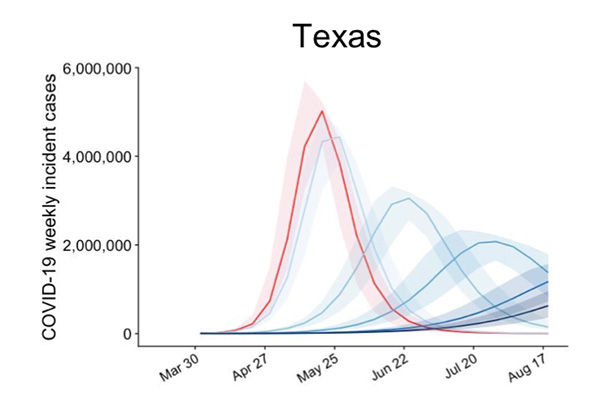Editor’s note: This story is part of The Daily Texan’s coverage of how coronavirus concerns are affecting UT-Austin. Read the rest of our coverage here.
UT researchers published their projections for 22 metro areas in Texas two weeks ago to determine when surges of COVID-19 will take place and how to mitigate the spread of the disease. The researchers are continually updating the data as projections change.
The team started working on the projections for COVID-19 in January. Integrative biology professor Lauren Ancel Meyers led the project and was the corresponding author, accompanied by researchers and graduate students, including research associate Spencer Fox.
Fox said Meyers has been working on projections for pandemics for the past two years and was modeling for a flu pandemic before the COVID-19 outbreak.
Fox said the team based their projections off a combination of factors, including how long people are infectious, how many people don’t show symptoms and the cases that have been seen so far in cities.
“The model incorporates the epidemiological characteristics we understand about the disease, and then it also incorporates the population and mobility structures of people across the (United States) in general,” Fox said.
The team has been in communication with the 22 metro areas since the beginning of the project, Fox said. While cities have been responsive to the data coming from this research, most are taking a variety of factors into account, he said.
“There’s a lot of uncertainty around how community transmission will happen and the extent to which it happens,” Fox said. “We’re trying to present the city … with plausible scenarios that are derived from the best available data that we can get.”
Fox said the city of Austin has responded well to the outbreak and has adjusted its COVID-19 regulations as the data continues to change.
On April 8, the city presented a plan to manage COVID-19 cases based on these projections, which showed that the peak would be smaller and further down the road with a larger percentage of people practicing social distancing. At the press conference, Travis County judge Sarah Eckhardt said the plan was put in place based on a 50% decrease in nonessential activity.
Sam Haynes, a senior public information specialist for the city of Austin, said the projections are being used to help prepare for a surge by predicting the number of hospital beds that will be necessary to care for patients.
Haynes said the current hospital bed count for Austin-Travis County is approximately 4,300 on an average day, although the number will change as the city expands its capacity.
“As of early April, hospitals are currently operating at about a 50% capacity,” Haynes said. “Should COVID-19 result in an overcapacity of our hospital system, we have a surge plan in place to address additional patient care needs.”
Haynes said the city of Austin is prepared to set up Type I and Type II alternative care sites. Type II would consist of hospital-style care and would be used after hospitals were filled, Haynes said, while Type I would consist of a large ward similar to a combat surgical hospital.
Fox said the team’s understanding of the disease has changed drastically in the past month.
“I would say the biggest question three or four weeks ago was whether interventions that are being put in place in cities … across the country will be enough to halt the spread of the disease,” Fox said. “The big open question right now is how can we return to a somewhat sense of normalcy while also making sure that epidemics don’t flare up again.”















